Kay can't find deadly curveball in tough-luck Toronto debut

TORONTO — Anthony Kay had every reason to feel confident heading into Friday night’s matchup against the New York Yankees.
He was coming off an excellent debut, he was going to have a home crowd behind him for the first time, and his opponent was sitting their two most dangerous hitters (Aaron Judge and Gary Sanchez).
That seemed like a recipe for a solid outing, and for four innings that looked like exactly what the southpaw would provide as he put up zeros. Unfortunately for Kay, everything went sideways in a fifth where he was charged with five runs and squandered a 3-0 lead in what ultimately went down a 6-5 walk-off win for Toronto. That seems like a strong indictment of his work on the mound, but it’s worth noting that the defence behind him was appalling.
First Teoscar Hernandez turned a single into a double with an ill-advised slide:
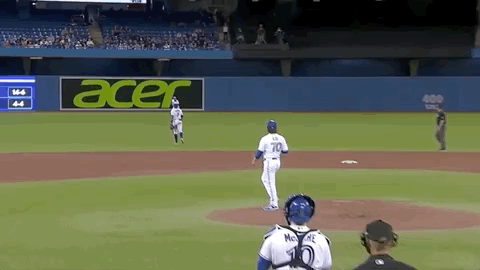
Then Randal Grichuk airmailed a throw to second base:
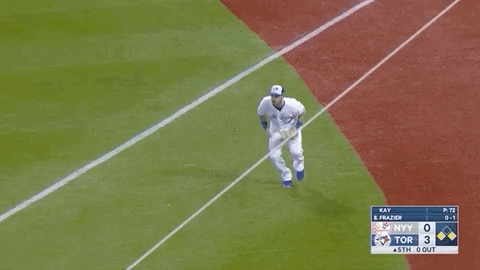
Then, a couple of hitters later, Vladimir Guerrero Jr. failed to register an out on a groundball in an attempt to make a double play that was never going to happen.
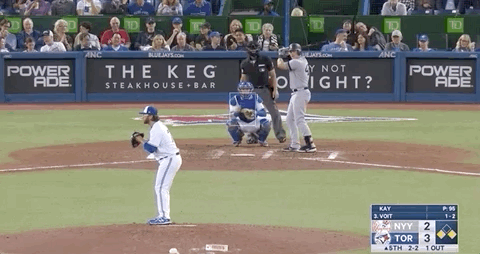
“It was more the defence than Kay,” manager Charlie Montoyo said. “He did the job. A couple of misplayed balls, a ball thrown to the wrong base... there were many things that happened where the defence didn’t help.”
Those blunders don’t account for all the runs to cross by any means, but they help explain how Kay got so far off course. Jason Adam coming in and promptly throwing a wild pitch then allowing a two-run single also helps account for the events of the doomed inning. Basically, Kay’s teammates could not have done worse by him.
That said, he still allowed four consecutive hits to begin the fifth, equalling the four he conceded in his debut. In his 4.1 frames, he managed just two strikeouts compared to the eight he coaxed out of the Rays on Saturday. There’s no doubt the 24-year-old didn’t pitch as well as he did that day.
So, what was missing?
The most obvious answer is his curveball. On Saturday, Kay’s primary breaking ball was his most dangerous offering. The rookie got seven of his eight strikeouts with it, despite throwing it just 16 times on the day.
In an appearance on Sportsnet 590 The Fan on Tuesday, he talked about the progress he’s made with the pitch since joining the Blue Jays organization - saying the following:
“One thing I was working on was getting my curveball more up and down rather than side to side. It was more of a sliderishy pitch when I was with the Mets. One thing I always wanted to work on was getting it more 12-6”
While Kay’s breaking ball still carries a fair amount of horizontal movement (2.7 inches more than league average), it was mighty effective in his debut as he was able to get hitters to chase it...
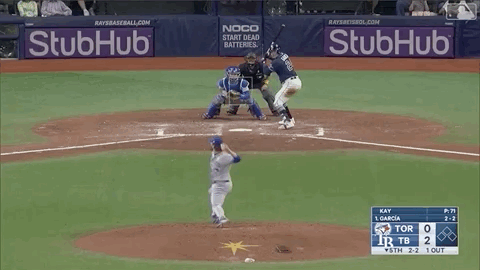
... and watch it for strike three.
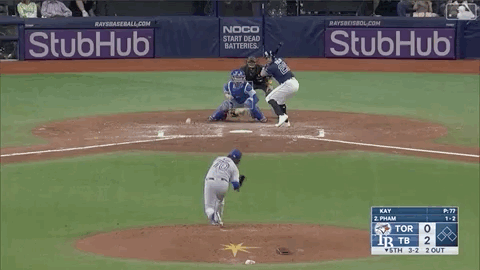
That pitch just didn’t make an appearance on Friday night. Kay got just one swinging strike and left it in the lower third of the zone - where it could be hit or fouled off - a little too often, allowing the Yankees to average a 91.6 mph exit velocity on it. Put simply, it didn’t look sharp - although Kay himself remained optimistic about the hook.
“It was good, they were just making contact,” he said. “For the most part I was getting groundballs with it not swing and misses.”
Although he did get some of those groundballs, he also allowed two hits at over 100 mph out of the four times the curve was put in play. So it wasn’t as if he sacrificed whiffs for soft contact.
Because Kay is a three-pitch pitcher (fastball, changeup, curve), there just isn’t much room for him to be missing any of his pitches in a given start. That doesn’t mean he won’t be successful, there are plenty of guys who thrive with a similar arsenal. It’s just really hard to survive fastball-changeup unless that change is truly elite.
The importance of the curve was made especially notable by the fact Kay’s fastball was really good on Friday. He got eight swinging strikes with it and earned his first two career K’s with the pitch. Kay hit a career-best 96.2 mph in an at-bat with Didi Gregorius and looked plenty capable of climbing the ladder as he did with Brett Gardner in the second:
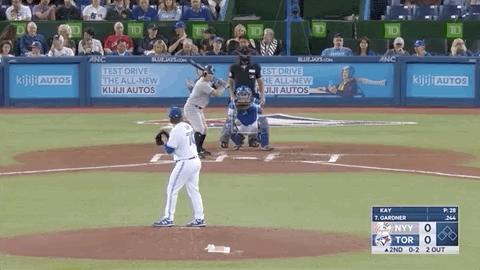
Kay’s heater is a good pitch, but he’s no Justin Verlander. Mowing down lineups using almost exclusively the hard stuff isn’t going to work for him. It didn’t work on Friday, even with the help of a changeup he generally commanded well.
Looking at Kay’s line - 4.1 innings with five earned runs, one walk, and two strikeouts - you might assume his outing against the Yankees was a disaster. That would be the wrong way to describe it considering the tough luck he incurred.
“I’ll check the video see if I left anything over the plate, see if I was executing my pitches, stuff like that,” he said. “[But] the five runs, I don’t think indicates how well I threw the ball today.”
It did serve as a bit of a cautionary tale, though. When the plus curveball isn’t clicking things are going to be a lot harder for Kay.
More Blue Jays coverage from Yahoo Sports Canada

 Yahoo Sports
Yahoo Sports 

